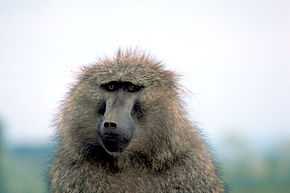Cercopithecidae
|
|
Cet article est une ébauche concernant les primates. Vous pouvez partager vos connaissances en l’améliorant (comment ?) selon les recommandations du projet correspondant.
Consultez la liste des tâches à accomplir en page de discussion. |
Cercopithécidés

Babouin anubis (Papio anubis)
| Règne | Animalia |
|---|---|
| Embranchement | Chordata |
| Classe | Mammalia |
| Ordre | Primates |
| Sous-ordre | Haplorrhini |
| Infra-ordre | Simiiformes |
| Micro-ordre | Catarrhini |
Cercopithecoidea
Gray, 1821
Cercopithecidae
Gray, 1821
Les cercopithécidés (Cercopithecidae) constituent une famille de primates catarhiniens à queue non-préhensile de l'Ancien Monde. Cette famille comprend notamment les cercopithèques, les cynocéphales et les macaques.
Le magot Macaca sylvanus est le seul macaque dépourvu de queue, mais aussi le seul singe présent sur le continent européen. Son aire de répartition comprend l'Afrique du Nord et Gibraltar.
On a découvert qu'une espèce de macaques était porteuse du facteur rhésus, ce qui lui a valu son nom de « macaque rhésus ». Ainsi, le macaque rhésus est devenu un animal de laboratoire populaire de par la similitude entre son patrimoine génétique et celui de l'Homme.
Position phylogénétique
| Primates |
| ||||||||||||||||||||||||||||||||||||
| |
Les cercopithecidae sont apparus au Miocène ancien (il y a environ 19 Ma) et constituent actuellement le groupe des catarrhiniens le plus diversifié taxonomiquement. Ils se distinguent des hominoïdés notamment par leurs molaires très spécialisées, appelées bilophodontes.
Classification
La classification de ces singes est encore en variable selon les auteurs et les sources.
Liste des sous-familles
Selon ITIS (30 mars 2011)[1], Mammal Species of the World (30 mars 2011)[2] et NCBI (30 mars 2011)[3] :
- sous-famille Cercopithecinae Gray, 1821
- sous-famille Colobinae Jerdon, 1867
Il faut ajouter la sous-famille des Victoriapithecinae qui regroupe exclusivement des fossiles[réf. nécessaire].
Liste des genres
Selon Mammal Species of the World (30 mars 2011)[2] :
- sous-famille Cercopithecinae
- genre Allenopithecus
- genre Cercocebus
- genre Cercopithecus
- genre Chlorocebus
- genre Erythrocebus
- genre Lophocebus
- genre Macaca
- genre Mandrillus
- genre Miopithecus
- genre Papio
- genre Theropithecus
- sous-famille Colobinae
- genre Colobus
- genre Nasalis
- genre Piliocolobus
- genre Presbytis
- genre Procolobus
- genre Pygathrix
- genre Rhinopithecus
- genre Semnopithecus
- genre Simias
- genre Trachypithecus
- sous-famille Cercopithecinae
- genre Allenopithecus
- genre Cercocebus
- genre Cercopithecus
- genre Chlorocebus
- genre Erythrocebus
- genre Lophocebus
- genre Macaca
- genre Mandrillus
- genre Miopithecus
- genre Papio
- genre Rungwecebus
- genre Theropithecus
- sous-famille Colobinae
- genre Colobus
- genre Nasalis
- genre Piliocolobus
- genre Presbytis
- genre Procolobus
- genre Pygathrix
- genre Rhinopithecus
- genre Semnopithecus
- genre Trachypithecus
Et pour les fossiles[réf. nécessaire] :
- sous-famille Victoriapithecinae
- genre Victoriapithecus (Miocène moyen)
- genre Prohylobates (Miocène ancien)
Notes et références
Vour aussi
Bibliographie
- Cachel S. (2006) Primate and Human Evolution, Cambridge University Press, Cambridge
Liens externes
- Référence Tree of Life Web Project : Cercopithecidae (en)
- Référence Fossilworks Paleobiology Database : Cercopithecidae Gray 1821 (en)
- Référence Mammal Species of the World : Cercopithecidae Gray, 1821 (en)
- Référence Catalogue of Life : Cercopithecidae (en)
- Référence Fauna Europaea : Cercopithecidae (en)
- Référence ITIS : Cercopithecidae Gray, 1821 (fr) ( (en))
- Référence Animal Diversity Web : Cercopithecidae (en)
- Référence NCBI : Cercopithecidae (en)
- Référence UICN : taxon Cercopithecidae (en)
- Référence CITES : famille Cercopithecidae (sur le site de l’UNEP-WCMC) (fr+en)
- Portail des primates